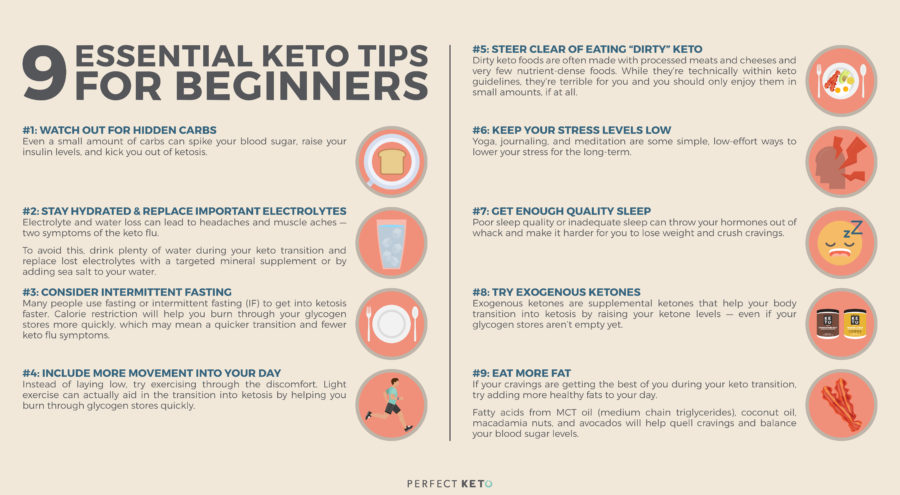In today’s fast-paced world, where our lives are filled with numerous responsibilities and demands, taking care of our health often takes a backseat. However, making conscious choices towards a healthier lifestyle is not as daunting as it may seem. If you have ever considered embarking on a transformative journey towards a balanced and nourishing diet, then the keto diet might be the perfect fit for you.
Within the vast array of diet options available, the keto diet stands out for its ability to facilitate weight loss, boost energy levels, and improve cognitive function. By significantly reducing carbohydrate intake and increasing the consumption of healthy fats, the keto diet encourages your body to enter a metabolic state called ketosis.
During ketosis, your body relies on fat as its primary source of fuel instead of carbohydrates. This shift in energy production allows you to burn fat efficiently, leading to rapid weight loss and increased mental clarity. Moreover, the keto diet has been linked to various health benefits such as reducing inflammation, improving heart health, and managing certain medical conditions.
Embarking on a new diet can be overwhelming, especially if you are new to the concept. However, fear not! This beginner’s guide aims to provide you with easy-to-follow steps to start your keto journey. From understanding the fundamentals of the diet to practical tips on meal planning and overcoming challenges, we will guide you every step of the way towards a healthier and happier you. So, let’s dive into the world of keto and discover how you can completely transform your lifestyle!
- Step 1: Understanding the Fundamentals
- What is the Keto Diet?
- Exploring the Science behind Ketosis
- Differentiating between Ketogenic and Low-Carb Diets
- Step 2: Getting Started on the Keto Journey
- Calculating Your Macros
- Determining Your Ideal Daily Calorie Intake
- Understanding the Right Ratio of Macronutrients
- Step 3: Planning Your Keto Meals
- Questions and answers
Step 1: Understanding the Fundamentals
In this initial stage of embarking on a ketogenic journey, it is crucial to lay a solid foundation by gaining a deep comprehension of the fundamental principles underlying the keto lifestyle. By grasping these essentials, you will set yourself up for a successful and sustainable experience.
| Term | Definition |
| Macronutrients | The three primary macronutrients include carbohydrates, proteins, and fats, which constitute the main components of our diet. |
| Ketosis | A metabolic state in which the body predominantly burns fat for fuel instead of carbohydrates, leading to increased fat loss and improved energy levels. |
| Net Carbs | The total carbohydrates in a given food item minus the grams of fiber, which is subtracted as it has minimal impact on blood sugar levels. |
| Fat Adaptation | The process during which the body becomes efficient at utilizing fat as its primary source of energy, enhancing weight loss and overall wellness. |
Additionally, comprehending the potential health benefits, such as improved mental clarity, increased energy, and reduced inflammation, will motivate you to embrace the keto lifestyle wholeheartedly.
By delving into the basics, you will build a solid knowledge foundation, paving the way for subsequent steps in your keto journey. This understanding will enable you to make informed decisions and effectively customize the diet to your individual needs.
What is the Keto Diet?
The concept of the Keto Diet revolves around a particular way of eating that has gained popularity in recent years. It focuses on a low-carbohydrate, high-fat approach to food consumption, aimed at shifting the body’s metabolism into a state called ketosis.
This dietary regimen, alternatively known as the ketogenic diet, emphasizes replacing carbohydrates, such as grains, sugars, and starchy vegetables, with sources of healthy fats, proteins, and non-starchy vegetables. This shift in macronutrient intake encourages the body to enter a metabolic state wherein it relies on fat as its primary source of energy, rather than glucose derived from carbohydrates.
The Keto Diet can be considered as a lifestyle that requires careful attention to food choices and macronutrient ratios. It involves consuming meals that are rich in fats and moderate in proteins, while restricting carbohydrate intake to minimal levels. By doing so, the body’s energy production shifts from primarily burning glucose to using ketones, which are produced by the liver through the breakdown of fats.
Benefits attributed to the Keto Diet include weight loss, improved mental clarity, enhanced energy levels, and potentially even therapeutic effects for certain medical conditions. However, it is essential to approach this dietary approach with proper knowledge and guidance to ensure balanced nutrition, adequate vitamin and mineral intake, and long-term sustainability.
While the Keto Diet may not be suitable for everyone, it has gained a significant following and remains a topic of interest for those seeking to explore a different approach to nutrition and potential health benefits.
It is important to consult with a healthcare professional or qualified nutritionist before embarking on any significant dietary changes to address individual needs and determine if the Keto Diet is right for you.
Exploring the Science behind Ketosis

Delving into the scientific aspects of ketosis opens up a world of understanding about the process by which our bodies switch from using carbohydrates for energy to burning fat instead. This section will shed light on the underlying mechanisms that drive ketosis and its numerous benefits.
1. Carbohydrate Restriction: One of the key factors that trigger ketosis is the reduction in carbohydrate intake. By significantly cutting down on carbs, the body is forced to find an alternative fuel source to meet its energy requirements.
2. Fat Adaptation: In the absence of sufficient carbohydrates, the body begins to break down stored fat into molecules called ketones. These ketones then serve as the primary source of fuel for various bodily functions, including the brain, muscles, and organs.
3. Metabolic Shift: As the body becomes adapted to using ketones for energy, a metabolic shift occurs. This shift involves changes in various hormones and enzymes, fostering an environment conducive to fat burning and weight loss.
4. Insulin Regulation: Restricting carbohydrates helps regulate insulin levels in the body. Since insulin plays a crucial role in storing excess glucose as fat, reducing its production and secretion can facilitate fat loss and improve overall metabolic health.
5. Enhanced Fat Burning: Ketosis promotes enhanced fat burning due to several reasons, including increased fat oxidation, reduced fat storage, and improved utilization of stored fat as fuel. This process can lead to greater weight loss and improved body composition.
6. Mental Clarity: Many individuals report heightened mental clarity and improved cognitive function while in ketosis. This may be attributed to the brain’s efficient utilization of ketones as an energy source, optimizing brain health and function.
7. Blood Sugar Control: The ketogenic diet has shown promising results in improving blood glucose control, especially for individuals with type 2 diabetes. By minimizing carb intake, ketosis helps regulate blood sugar levels and reduces reliance on exogenous insulin.
8. Appetite Suppression: Ketosis has been associated with reduced hunger and increased satiety. The higher fat content in the diet and the steady release of ketones contribute to feeling fuller for longer periods, aiding in calorie restriction and weight management.
This exploration of the science behind ketosis highlights the intricate interplay between diet, metabolism, and overall health. Understanding the underlying mechanisms can empower beginners to make informed decisions and embark on a keto journey with confidence.
Differentiating between Ketogenic and Low-Carb Diets
Understanding the distinctions between ketogenic and low-carb diets is essential for those embarking on a journey towards a healthier lifestyle. While these two dietary approaches share a similar goal of reducing carbohydrate intake, they differ in the extent of carbohydrate restriction and their impact on the body’s metabolic state.
One key factor that sets the ketogenic diet apart is its focus on achieving a state of ketosis – a metabolic process where the body utilizes fat for fuel instead of carbohydrates. This requires an extremely low carbohydrate intake, typically around 20-50 grams per day, forcing the body to rely on stored fat as its primary source of energy. By limiting carbohydrates to such a degree, the body enters a state of ketosis, producing ketones that provide energy for both the body and the brain.
On the other hand, a low-carb diet emphasizes reducing carbs to a lesser extent than the ketogenic approach. While the exact carbohydrate limit may vary, low-carb diets typically involve consuming anywhere between 50-150 grams of carbs per day. This moderate restriction still encourages the body to rely more on fat for fuel but may not necessarily induce a state of ketosis.
Another important distinction lies in the sources of carbohydrates allowed in each diet. The ketogenic diet encourages the consumption of healthy fats, such as avocados, nuts, and coconut oil, while strictly limiting high-carb foods like grains, starchy vegetables, and most fruits. In contrast, low-carb diets often include a wider range of carbohydrate sources, including certain whole grains, legumes, and fruits.
Moreover, the duration and purpose of these diets differ as well. The ketogenic diet is commonly used for therapeutic purposes, such as managing epilepsy or supporting weight loss, and is usually followed for an extended period of time. Low-carb diets, on the other hand, may be adopted as a long-term lifestyle change or for short-term weight loss goals.
Understanding these differences is crucial for selecting the approach that aligns with individual goals and preferences. Whether one chooses to follow a ketogenic or low-carb diet, both can be effective in promoting weight loss, improving metabolic health, and providing numerous other health benefits when followed appropriately.
Step 2: Getting Started on the Keto Journey
To embark on your keto journey, it’s essential to understand the fundamental principles and steps involved in adopting a ketogenic diet. This section will guide you through the initial stages of transitioning to a keto-friendly eating plan without overwhelming you with complex details.
When starting your keto journey, you need to focus on certain key aspects. These include understanding the concept of ketosis, identifying high-fat and low-carb food choices, and implementing meal planning strategies. By embracing these fundamentals, you’ll set yourself up for success and effectively kickstart your keto lifestyle.
Understanding Ketosis: One of the critical concepts behind the keto diet is achieving a state of ketosis. This metabolic state occurs when your body starts using fat as its primary source of fuel instead of carbohydrates. The transition into ketosis involves limiting your carbohydrate intake, primarily from foods like grains, sugars, and starchy vegetables.
Identifying Keto-Friendly Foods: As you delve into the keto diet, it’s important to familiarize yourself with the types of foods that support ketosis. These include high-fat options such as avocados, nuts and seeds, oils, fatty fish, and quality dairy products. Conversely, you’ll need to minimize your consumption of carbohydrates, focusing on low-carb vegetables, lean proteins, and healthy fats.
Implementing Meal Planning: Meal planning is a crucial aspect of maintaining a ketogenic lifestyle. By planning your meals in advance and ensuring they align with the keto-friendly guidelines, you’ll be able to stay on track and achieve your desired results. Additionally, meal planning can help you save time, money, and avoid spontaneous food choices that may hinder your progress.
To summarize, embarking on the keto journey involves familiarizing yourself with the concept of ketosis, identifying suitable keto-friendly foods, and implementing effective meal planning strategies. By taking these crucial steps, you’ll be well on your way to reaping the numerous benefits of the keto diet.
Calculating Your Macros
Understanding the ideal distribution of macronutrients plays a crucial role in the success of your ketogenic journey. By accurately calculating your macros, or macronutrient intake, you can effectively manage your daily diet to achieve desired results.
Determining the optimal balance between carbohydrates, proteins, and fats tailored to your individual needs will allow you to attain and maintain a state of ketosis, where your body burns fat for energy instead of glucose. This personalized approach ensures that your body receives the necessary fuel while promoting weight loss and overall health.
When calculating your macros, you’ll need to consider factors such as your body weight, activity level, and specific goals – whether it’s weight loss, muscle gain, or simply maintaining a healthy lifestyle. By using a reliable online calculator or seeking guidance from a nutritionist, you can easily determine the recommended macronutrient ratios to follow.
It’s important to note that your daily carbohydrate intake should be significantly reduced, typically to around 20-50 grams, to achieve and sustain ketosis. Protein intake should be moderate, focusing on high-quality sources such as lean meats, poultry, fish, and plant-based proteins. Finally, the majority of your calorie consumption should come from healthy fats, including avocados, nuts, seeds, and oils.
Regularly monitoring and adjusting your macros as needed will ensure you stay on the right track and maintain ketosis. Pay attention to how your body responds to different macronutrient ratios and tweak them accordingly for optimal results. Remember, finding your ideal macros is a personalized process that may require experimentation and self-awareness.
Determining Your Ideal Daily Calorie Intake
Understanding your body’s energy needs is an essential step in starting the ketogenic diet. By determining your ideal daily calorie intake, you can create a personalized plan that supports your health and weight goals. Calorie intake plays a crucial role in enabling your body to enter ketosis, a metabolic state in which it burns fat for energy instead of carbohydrates.
To calculate your ideal daily calorie intake, you need to consider several factors. These include your current weight, height, age, and activity level. Additionally, it’s essential to consult with a healthcare professional or nutritionist to ensure accuracy and safety.
| Activity Level | Daily Calorie Intake |
|---|---|
| Sedentary (little to no exercise) | Calorie Intake = Basal Metabolic Rate (BMR) x 1.2 |
| Lightly Active (light exercise/sports 1-3 days/week) | Calorie Intake = BMR x 1.375 |
| Moderately Active (moderate exercise/sports 3-5 days/week) | Calorie Intake = BMR x 1.55 |
| Very Active (hard exercise/sports 6-7 days/week) | Calorie Intake = BMR x 1.725 |
| Super Active (very hard exercise/sports & physical job or 2x training) | Calorie Intake = BMR x 1.9 |
To determine your Basal Metabolic Rate (BMR), you can use an online calculator or consult with a healthcare professional. BMR represents the number of calories your body needs to maintain basic bodily functions at rest. Once you have your BMR, multiply it by the appropriate activity level factor to find your ideal daily calorie intake.
Remember, the ketogenic diet focuses on a high-fat, moderate-protein, and low-carb approach to nutrition. As you determine your ideal daily calorie intake, be sure to adjust the macronutrient ratios to align with the principles of the ketogenic diet. Consulting with a healthcare professional or nutritionist can help you create a personalized plan that optimizes your health and weight loss goals while following the ketogenic lifestyle.
Understanding the Right Ratio of Macronutrients

One of the key aspects in following a successful ketogenic diet is understanding the correct proportion of macronutrients. Macronutrients refer to the three essential components of our diet: carbohydrates, fats, and proteins. The right balance of these macronutrients is crucial for achieving and maintaining a state of ketosis, where the body burns fat for fuel instead of carbohydrates.
Carbohydrates provide our bodies with energy and are found in a wide variety of foods such as grains, fruits, and vegetables. However, in a keto diet, the consumption of carbohydrates needs to be restricted to a very low level. This limitation encourages the body to enter a state of ketosis.
Fats are the central component of the ketogenic diet and should make up the majority of your calorie intake. Contrary to popular belief, not all fats are unhealthy. Healthy fats like those found in avocados, nuts, and olive oil are essential for the body to function optimally on a keto diet. These fats provide a slow and steady energy source, help keep you feeling full, and play a vital role in supporting various bodily functions.
Proteins play a crucial role in repairing tissues, building muscles, and maintaining proper immune function. While it is important to include an adequate amount of protein in your diet, it is equally important not to overconsume it. Excessive protein intake can potentially hinder the body’s ability to enter and maintain a state of ketosis. Therefore, it is important to find the right balance of protein intake while following a keto diet.
Understanding and maintaining the right ratio of macronutrients is essential for a successful keto diet. It involves carefully planning and tracking your daily intake of carbohydrates, fats, and proteins to ensure you stay within the optimal range for achieving and maintaining ketosis. Consulting with a healthcare professional or a registered dietitian can also provide valuable guidance and support on establishing the right ratio of macronutrients to suit your individual needs and goals.
Step 3: Planning Your Keto Meals
Creating a well-thought-out meal plan is an essential aspect of successfully following the ketogenic diet. By carefully organizing your meals, you can ensure that you consume the right balance of macronutrients and stay within your daily carb limit. This step will guide you through the process of planning your keto meals, allowing you to enjoy a variety of delicious and satisfying dishes while achieving your health and weight loss goals.
One helpful strategy for planning your keto meals is to focus on incorporating a diverse range of high-fat foods that are low in carbohydrates. This includes a wide selection of meats, such as beef, poultry, and fish, as well as healthy sources of fat like avocados, nuts, and seeds. It’s also important to include an array of non-starchy vegetables, such as leafy greens, broccoli, cauliflower, and zucchini, to add fiber and micronutrients to your diet.
To keep track of your daily macronutrient intake, maintaining a food diary or using a keto meal planning app can be highly beneficial. These tools enable you to accurately measure the amount of fat, protein, and carbohydrates in each meal, ensuring that your ratios align with the principles of the ketogenic diet. Additionally, planning your meals in advance can help you avoid impulsive food choices and make healthier decisions while grocery shopping.
Another useful tip when planning your keto meals is to incorporate intermittent fasting. This eating pattern involves extending the hours between your last meal of the day and the first meal of the following day, allowing your body to enter a state of ketosis more quickly. By strategically timing your meals within a restricted eating window, you can enhance the metabolic benefits of the keto diet and potentially accelerate weight loss.
Furthermore, to add variety and excitement to your keto meals, don’t hesitate to explore new recipes and experiment with different cooking techniques. There is a vast array of keto-friendly cookbooks, websites, and social media platforms that offer a myriad of flavorful and creative meal ideas. Incorporating these diverse and enjoyable recipes can make sticking to the ketogenic diet an enjoyable and sustainable lifestyle choice.
| Key Points: |
|---|
| – Incorporate a diverse range of high-fat, low-carb foods |
| – Include non-starchy vegetables for added fiber and nutrients |
| – Keep track of macronutrients using a food diary or app |
| – Consider incorporating intermittent fasting |
| – Explore new recipes and cooking techniques for variety |
Questions and answers
What is the keto diet?
The keto diet is a low-carb, high-fat diet that aims to convert the body into a state of ketosis, where it burns fat for fuel instead of carbohydrates.
Is the keto diet suitable for beginners?
Yes, the keto diet can be followed by beginners. It may take some time for your body to adapt to the low-carb intake, but with proper guidance, it is achievable.
What are some easy steps to start the keto diet?
To start the keto diet, you need to calculate your macronutrient intake, reduce your carbohydrate intake to 20-50 grams per day, increase your fat consumption, incorporate moderate protein, and stay hydrated.
Are there any potential side effects of the keto diet?
Yes, some people may experience side effects such as keto flu, which may include fatigue, headaches, and dizziness. It is important to stay properly hydrated and consume electrolytes to minimize these effects.
Can the keto diet help with weight loss?
Yes, the keto diet has been shown to be effective for weight loss. By eliminating carbohydrates and increasing fat intake, the body is forced to burn fat stores, resulting in weight loss.
What is the keto diet?
The keto diet is a low-carb, high-fat diet that involves reducing your carbohydrate intake and replacing it with healthy fats. It aims to put your body into a metabolic state called ketosis, where it burns fat for fuel instead of carbohydrates.
What foods are recommended on the keto diet?
The keto diet primarily focuses on consuming foods that are high in healthy fats, such as avocados, nuts, seeds, olive oil, and coconut oil. It also includes a moderate amount of protein from sources like meat, eggs, and dairy products. Low-carb vegetables like leafy greens, broccoli, and cauliflower are also allowed.
How does the keto diet help with weight loss?
The keto diet promotes weight loss by forcing your body to rely on fat as its main source of energy. By drastically reducing your carbohydrate intake, your body depletes its glycogen stores and starts breaking down stored fat for fuel. This can lead to a more rapid weight loss compared to other diets.
Are there any potential side effects of the keto diet?
While the keto diet can be effective for weight loss, it may cause some side effects in the initial stages. These can include headache, fatigue, dizziness, and constipation. These symptoms, often called the keto flu, usually subside within a few days as your body adjusts to ketosis.
Is the keto diet suitable for everyone?
The keto diet may not be suitable for everyone, especially those with certain medical conditions, including pancreatitis or liver disease. It’s always recommended to consult with a healthcare professional before starting any new diet, especially if you have any underlying medical concerns.

I’m Jake Morgan, a 23-year-old Keto diet and fitness expert from sunny California. Passionate about helping you achieve your dream body with the right nutrition and workout. Connect or consult via Telegram.






